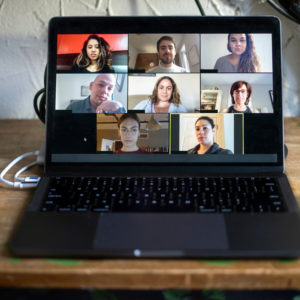Editor’s Note: For another viewpoint, see Point: Technology Can’t Replace In-Person Jury Trials, but It May Help During a Pandemic
“Could everyone turn their video back on?” rasps a disembodied voice.
The words accelerate to double time as you struggle to decipher a meaning with no body language to guide you. It’s been hours, you’re exhausted, and the worst part is you’re just getting started.
Sound like a Zoom conference from hell? Welcome to the new jury trial. Take a seat, juror.
A man testifies that his ex-wife beat him with a toaster. Look at her hand, he says, you can see burn marks where she gripped the inside. A hand appears on screen.
You think you see some lines, you’re not sure. She was on drugs, the man says, and the prosecutor asks if she’s ever been charged before. Yes, he replies, but the defense attorney is yelling “objection,” and after a period of silence the judge tells you to forget that.
Hours later, the defendant speaks. She tells you they have a daughter and her ex made up these accusations to get custody of their kid. Now she says he’s the drug user, but grating electronic feedback overtakes your audio before the prosecutor’s objection yields more silence.
Another juror is petting a cat.
Could you tell who is telling the truth in this scenario? The stakes are high: The state has charged this woman with aggravated assault and indicted her as a habitual felon. You won’t know it at trial, but she’s facing a six-year sentence during which her ex-husband would get full custody of their child.
Zoom court is in session across much of America.
There’s a lot we don’t know about virtual trials, but what we do know isn’t promising. The most prominent study of video conferencing software in the courtroom was a 10-year analysis of CCTV bail hearings in Cook County, Illinois.
The average amount of money judges made defendants pledge to be released before trial increased 51 percent after those hearings began and continued to rise, reversing a prior downward trend. Even more alarming, video bail hearings lasted under 30 seconds: rapid-fire determinations of whether defendants would remain in jail despite the Illinois legislature prescribing dozens of release considerations.
While video technology has changed since the 1999-2009 study, our thirst for a more “efficient” administration of judgment has not. If the metric of efficiency is convictions, the United States is the unchallenged leader: America incarcerates more than five times more people per capita than the average first-world nation.
This incarceration rate would be a logistical impossibility without the clever machinations through which the state has dismantled the power of the jury.
Juries have suffered a devastating fall from grace since John Peter Zinger was famously acquitted for the crime of seditious libel against the British Crown. The jury our Founders envisioned could acquit the redundant “habitual felon” charge in our case above if they thought one year, rather than six, were appropriate.
And charges that routinely make rounds in courthouses today — disorderly conduct, marijuana possession and the latest invention — “staying out past curfew” — would never survive the kind of jury trial the Sixth Amendment was supposed to guarantee.
But while the Supreme Court has acknowledged the jury’s right to conscientious acquittal, states have fenced around it with laws that criminalize informing a jury of their right to refuse enforcement of unreasonable laws. Instead, jurors are prescribed the all-too-familiar instruction that jurors must determine the facts, not the law.
Video trials will now make even this impossible, setting jurors to the unenviable task of discerning lies from truth through sound distortions, Zoom fatigue, and an absence of non-verbal communication.
Just 2 percent of federal criminal prosecutions go to a jury trial, while 90 percent result in guilty pleas. This is a far cry from the system of justice conceived at our nation’s founding, when the modern “plea bargain” was unheard of and the citizen jury trial was considered the high-water mark of political institutions.
Let’s not make things worse. Our assembly-line style of justice system already incarcerates more people than China and India combined.
There is another, wiser, more compassionate way. We can temporarily allow non-violent and low-risk offenders to await their day in court with no-money bail until courts reopen. This would also spare our accused from the rampant spread of coronavirus in prisons.
But we should not, as Justice Antony Scalia opined in the first Supreme Court case to examine video testimony, allow the “subordination of explicit constitutional text to currently favored public policy.”
The Sixth Amendment is too important to be another casualty of the pandemic.

